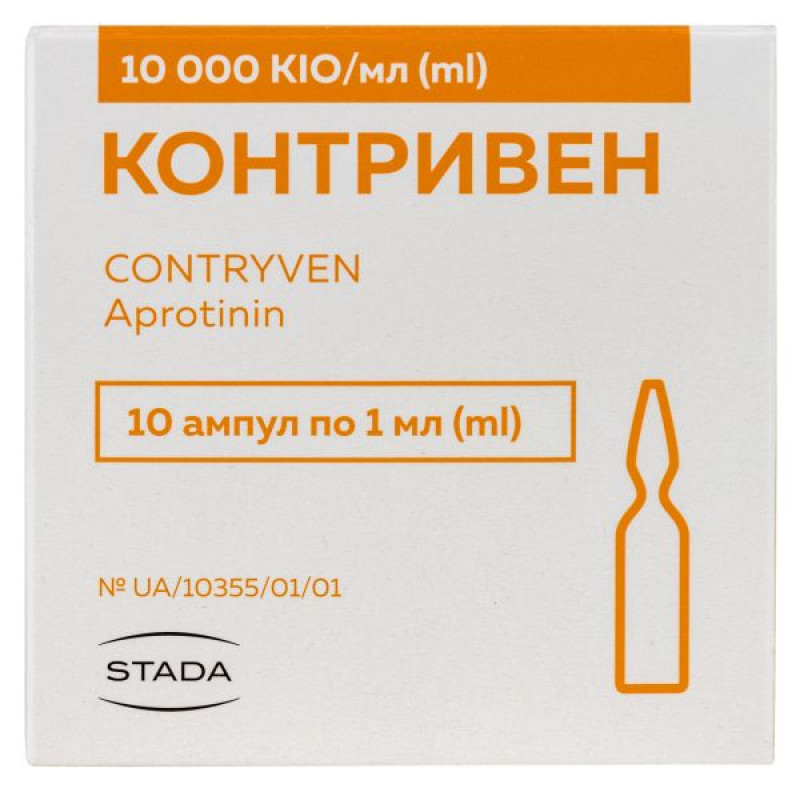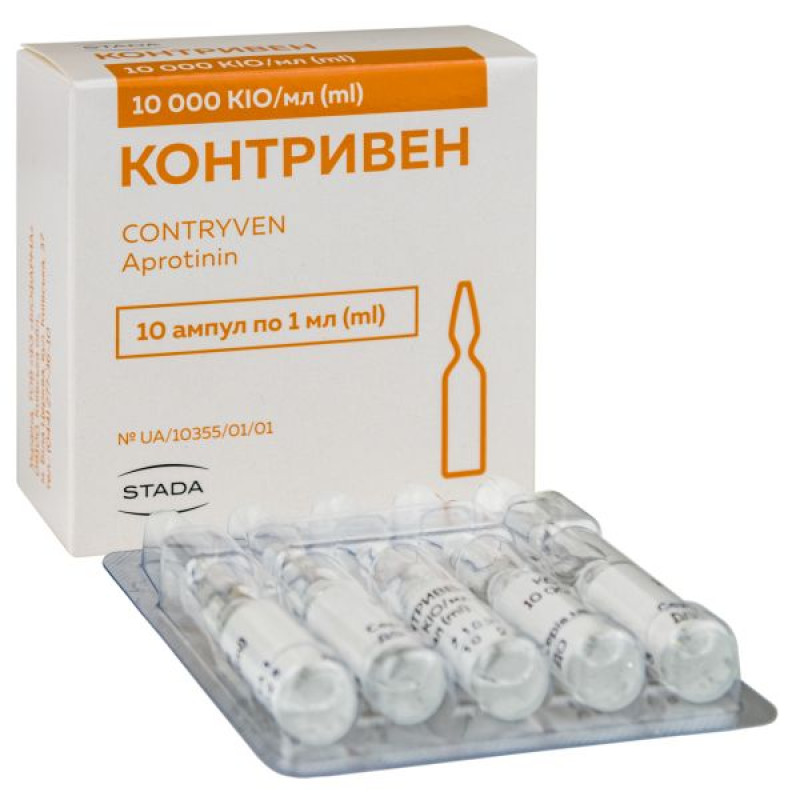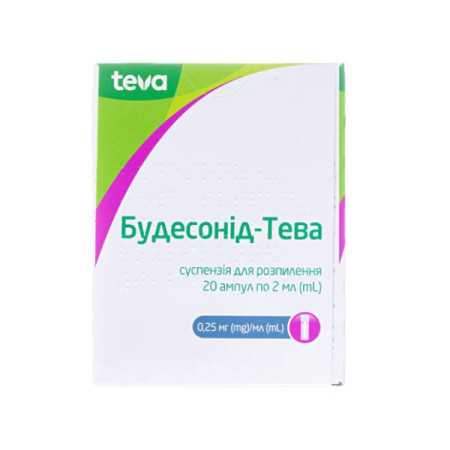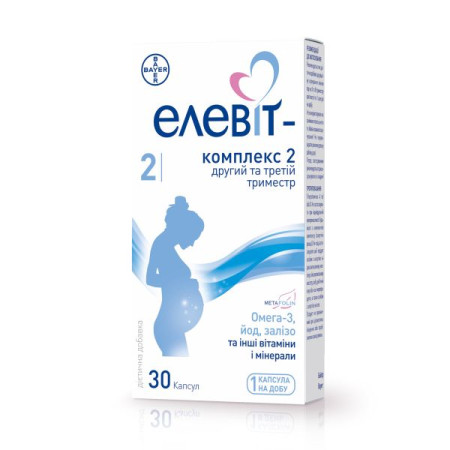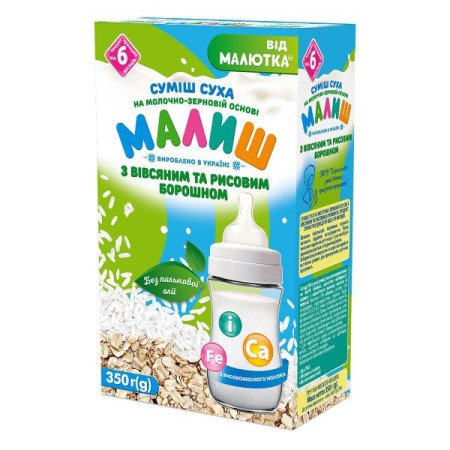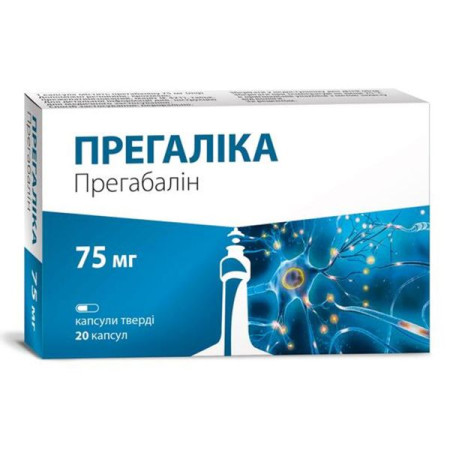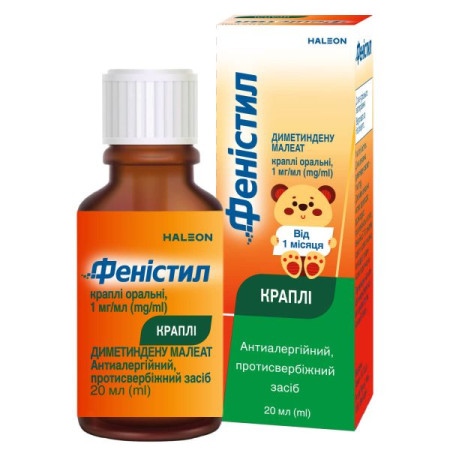Contriven solution for injection 10,000 kio/ml ampoule 1 ml No. 10
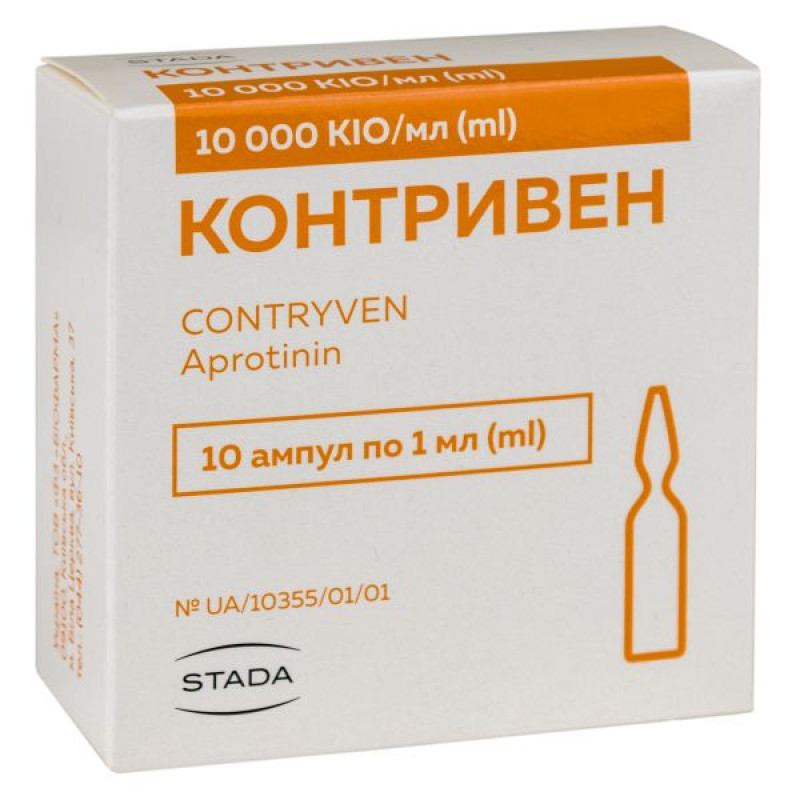
Instructions for use: Contriven solution for injection 10,000 kio/ml ampoule 1 ml No. 10
Composition
active ingredient: aprotinin;
1 ml of solution contains: 10,000 KIO aprotinin;
Excipients: sodium chloride, water for injections.
Dosage form
Solution for injection.
Main physicochemical properties: transparent, colorless or with a yellowish tinge liquid.
Pharmacotherapeutic group
Proteinase inhibitors. Aprotinin. ATC code B02A B01.
Pharmacological properties
Pharmacodynamics
Aprotinin is a broad-spectrum protease inhibitor molecule with antifibrinolytic activity. Forming a reversible stoichiometric enzyme-inhibitor complex, aprotinin inhibits trypsin, plasmin, and kallikrein in human blood plasma and tissues, which leads to inhibition of fibrinolysis.
In addition, it inhibits the contact phase of blood clotting activation, which is a factor in triggering the coagulation process and stimulating fibrinolysis.
Aprotinin is used during operations under conditions of artificial circulation because it reduces inflammatory reactions, which leads to a decrease in the need for allogeneic blood transfusion and blood loss, as well as a decrease in the need for repeated examination of the mediastinum for bleeding.
In patients undergoing coronary artery bypass grafting, the incidence of serum creatinine elevations of 0.5 mg/dL above baseline was significantly higher in patients receiving full-dose aprotinin than in the placebo group. In most cases, postoperative renal impairment was reversible and not serious; the incidence of serum creatinine elevations of 2 mg/dL or more above baseline was similar in the full-dose aprotinin and placebo groups.
Pharmacokinetics
After intravenous administration, aprotinin is rapidly distributed throughout the extracellular space, which is accompanied by a rapid decrease in the concentration of aprotinin in the blood plasma, the half-life is from 0.3 to 0.7 hours. Later, in particular 5 hours after administration, a terminal elimination phase occurs, in which the half-life is from 5 to 10 hours.
The placenta is probably not completely impermeable to aprotinin, but penetration is apparently extremely slow.
During surgery, mean steady-state plasma concentrations of aprotinin in patients receiving aprotinin during cardiac surgery ranged from 175 to 281 CIUD/mL using the following regimen:
2,000,000 CIUD as an initial dose intravenously; 2,000,000 CIUD in the initial pump priming solution and 500,000 CIUD per hour as a continuous intravenous infusion throughout the operation. The average steady-state plasma concentration during the operation after administration of half this dose ranged from 110 to 164 CIUD/mL.
Data from pharmacokinetic studies of aprotinin in healthy volunteers, in cardiac patients undergoing surgery under artificial circulation, and in women undergoing hysterectomy indicate that pharmacokinetic parameters in the dose range from 50,000 KIOD to 2,000,000 KIOD are linear.
Plasma protein binding was studied ex vivo. Approximately 20% of the antifibrinolytic activity was due to the unbound form in the protein-free layer, and 80% of the drug was bound to serum proteins.
At steady state, the volume of distribution was about 20 liters, and the total clearance from the human body was about 40 ml per minute.
Aprotinin accumulated in the kidneys and, to a lesser extent, in cartilage tissue.
The accumulation of the drug in the kidneys is the result of binding of aprotinin to the brush border of epithelial cells of the proximal tubules, as well as accumulation in the phagolysosomes of these cells. Accumulation in cartilage is due to the affinity of the parent aprotinin for acidic proteoglycans.
In other organs, the concentration of the drug was basically the same as in the blood serum. The lowest concentration of the drug was observed in the brain; aprotinin practically did not enter the cerebrospinal fluid.
Only a small amount of aprotinin crosses the placental barrier. The placenta cannot be considered completely impermeable to aprotinin, but the rate of penetration is extremely low.
The penetration of aprotinin into breast milk has not been studied.
Metabolism, elimination and excretion.
The aprotinin molecule is cleaved in the kidneys by lysosomal enzymes into shorter peptides or amino acids. In humans, less than 5% of the administered dose of aprotinin is excreted in the urine. After intravenous administration of 131I-labeled aprotinin to healthy volunteers, 25% to 40% of the labeled substance is excreted in the urine within 48 hours as metabolites. These metabolites had no inhibitory activity against enzymes.
There are no data on the use of the drug in patients with end-stage renal disease, but no clinically significant pharmacokinetic changes or obvious side effects have been observed in patients with renal impairment. Therefore, no specific dose adjustment is required in such cases.
Indication
Aprotinin is indicated for prophylaxis to reduce postoperative blood loss and the need for blood transfusion in adult patients at high risk of major blood loss during isolated cardiopulmonary bypass surgery (i.e. coronary artery bypass grafting that is not combined with other cardiovascular interventions).
Contraindication
Hypersensitivity to the active substance (bovine protein) or to any of the excipients, disseminated intravascular coagulation (DIC). Patients with specific IgG antibodies to aprotinin are at increased risk of anaphylaxis during treatment with aprotinin. Therefore, aprotinin therapy is contraindicated in such patients.
If testing for specific IgG antibodies to aprotinin before starting treatment is not possible, but it is assumed that the patient has received aprotinin treatment within the previous 12 months, administration of aprotinin is contraindicated.
Interaction with other medicinal products and other types of interactions
The drug should not be mixed with other drugs, including beta-lactam antibiotics (incompatible). It is forbidden to administer the drug together with solutions containing dextran, corticosteroids, parenteral nutrition solutions containing amino acids and lipids.
Depending on the dose, Contriven reduces the activity of streptokinase and urokinase. It may inhibit the activity of nonspecific cholinesterase in the blood serum. In patients with reduced activity of nonspecific cholinesterase, the simultaneous use of aprotinin and suxamethonium may cause apnea, which is caused by muscle relaxation.
Aprotinin inhibits the action of thrombolytic agents, including streptokinase, urokinase and alteplase (r-TAP = recombinant tissue plasminogen activator), and the inhibitory effect depends on the dose of the drug. If necessary, it can be diluted in 0.9% sodium chloride solution or in at least 500 ml of 5% glucose solution. The drug dissolved in glucose should be used within 4 hours.
The introduction of the drug into heparinized blood increases the clotting time of whole blood.
The use of aprotinin may lead to renal impairment, especially in patients with pre-existing renal impairment. The use of aminoglycosides also increases the risk of developing renal impairment.
Application features
Aprotinin should not be used during coronary artery bypass grafting (CABG) in combination with other cardiovascular procedures, as the benefit/risk ratio of aprotinin during other cardiovascular procedures has not been established.
Aprotinin treatment may be associated with renal impairment, particularly in patients with pre-existing renal impairment. In patients undergoing coronary artery bypass grafting, serum creatinine levels were shown to increase by 0.5 mg/dL above normal in the aprotinin group (see section 5.1). Accordingly, a careful benefit-risk assessment is required before prescribing aprotinin to patients with renal impairment or those at risk of renal impairment (e.g., those receiving concomitant aminoglycoside therapy).
Aprotinin should be used with caution in patients with atopic dermatitis, as pseudoallergic reactions may occur.
A careful benefit-risk assessment is necessary when using aprotinin, especially in patients who have previously used aprotinin (including fibrin sealants containing aprotinin), as they may develop an allergic reaction (see section "Adverse reactions"). Although in most cases anaphylaxis develops after the administration of the approved dose within 12 months, there are isolated reports of cases where anaphylactic reactions occurred with repeated administration after 12 months. During therapy with aprotinin, emergency facilities for the treatment of allergic and anaphylactic reactions should be available.
All patients receiving aprotinin treatment should first be given a test dose to assess for any susceptibility to allergic reactions (see section 4.2). The test dose should be administered to the patient in the operating room.
H1 and H2 antagonists can be administered 15 minutes before the aprotinin test.
The test dose of aprotinin for all patients should be 1 milliliter (10,000 KIOD), after which the patient should be observed for at least 10 minutes before administering a loading dose (see section “Method of administration and dosage”).
However, even despite the absence of complications in the period after the initial dose
1 ml, a therapeutic dose of aprotinin may cause an anaphylactic reaction. If an anaphylactic reaction develops, the aprotinin infusion should be stopped and the necessary emergency measures should be taken.
If it is known that the patient has already received or may receive repeated treatment with aprotinin, it is recommended to follow precautionary measures. As indicated in the section "Method of administration and dosage", all patients should be administered a test dose of aprotinin in a volume of 1 ml (10,000 KIOD) at least 10 minutes before the initial dose. In addition, an H1 antagonist (e.g. clemastine) and an H2 antagonist (e.g. cimetidine) can be administered 15 minutes before the test dose of the drug. If necessary, standard emergency measures should be used to treat an allergic (anaphylactic) reaction.
It should be noted, however, that a therapeutic dose may induce an allergic reaction, even if the patient tolerated the initial 1 ml test dose well without experiencing any adverse symptoms. If this occurs, the aprotinin infusion should be stopped immediately and standard emergency measures for the treatment of anaphylactic reactions should be initiated.
Patients treated with aprotinin had an increased incidence of renal dysfunction and mortality compared with age-matched controls who had a similar medical history and who had also undergone thoracic aortic surgery under cardiopulmonary bypass with profound hypothermia. In such cases, aprotinin should be used with extreme caution. Appropriate anticoagulant therapy with heparin should be instituted.
Monitoring of laboratory parameters of anticoagulation during coronary artery bypass grafting.
The use of aprotinin does not reduce the amount of heparin required, so it is very important that adequate anticoagulant activity due to the use of heparin is maintained during aprotinin therapy. In patients treated with aprotinin, an increase in partial thromboplastin time (PTT) and Celit-activated clotting time (CLT) is expected during surgery and for several hours after surgery.
Therefore, the partial thromboplastin time (PTT) should not be used to monitor maintenance of adequate anticoagulant activity with heparin. In patients undergoing coronary artery bypass grafting with aprotinin, one of three methods is recommended to maintain adequate anticoagulant activity: activated clotting time (ACT), fixed-dose heparin, or titration of heparin doses (see below).
When using activated clotting time (ACT) to maintain adequate anticoagulant activity, the minimum recommended duration of the ACT test with celite is 750 s or the ACT test with kaolin is 480 s in the presence of aprotinin, regardless of the effects of hemodilution and hypothermia.
Additional notes on the use of the drug in conditions of artificial blood circulation.
To maintain adequate anticoagulant activity during cardiopulmonary bypass with concomitant use of aprotinin, the use of any of the following methods is recommended:
Activated clotting time (ACT): The ACT cannot be considered a standard coagulation test; the interpretation of the results of this test depends on the presence of aprotinin. In addition, the test results are affected by differences in dilution and the temperature used in the conditions of artificial circulation. The effect of aprotinin has been shown to be less pronounced with kaolin ACT than with ACE. Despite the variety of protocols, it is recommended to perform a 750-second ACT with ACE or a 480-second ACT with kaolin in the presence of aprotinin, regardless of the degree of hemodilution and hypothermia. For advice on the interpretation of the test results in the presence of aprotinin, the manufacturer of the ACT reagents should be consulted. Administration of constant doses of heparin: The standard loading dose of heparin administered prior to cardiac catheterization and the amount of heparin added to the initial filling solution of the artificial circulatory device should be at least 350 IU/kg. The additional dose of heparin is determined taking into account the patient's body weight and the duration of the intervention under artificial circulatory conditions. Heparin/protamine titration: The results of this method are not affected by the presence of aprotinin, therefore it is acceptable for measuring heparin levels. The relationship between heparin dose and response should be assessed by protamine titration before administration of aprotinin (to determine the loading dose of heparin).
Additional heparin may be administered based on the heparin concentration measured by protamine titration. The heparin concentration under cardiopulmonary bypass should not fall below 2.7 U/mL (2 mg/kg) or below the dose determined in the heparin dose-response test performed prior to aprotinin administration.
Important: the use of aprotinin does not mean that the need for heparin is reduced; aprotinin cannot be used as a heparin-preserving agent.
This medicinal product contains less than 1 mmol (8.5 mg) sodium/1 ml and (42.5 mg) sodium/5 ml, i.e. essentially sodium-free.
Ability to influence reaction speed when driving vehicles or other mechanisms
The drug can only be used in a hospital setting.
Use during pregnancy or breastfeeding
There are no adequate and well-controlled studies in pregnant women. Animal studies do not indicate a teratogenic or embryotoxic effect of aprotinin. Aprotinin is contraindicated in the first trimester of pregnancy and should not be used in the second and third trimesters of pregnancy unless the potential benefit outweighs the potential risk. In the event of serious adverse reactions (such as anaphylactic reactions, cardiac arrest, etc.) and during their treatment, the potential risk to the fetus should be weighed against the potential benefit (see section 4.4).
It is not known whether aprotinin is excreted in human milk. There is no information on the use of Contriven during breastfeeding. However, since aprotinin is not bioavailable when taken orally, any amount of the drug that enters human milk will not affect the infant.
Method of administration and doses
All patients should be tested for specific IgG antibodies to aprotinin before starting the drug (see section "Contraindications"). The following dosages of the drug are recommended for adult patients:
Test dose.
Because of the risk of allergic (anaphylactic) reactions, all patients should be given 10,000 KIUD (kallikrein inhibitory units) of aprotinin (1 ml) intravenously at least 10 minutes before the initial dose. If the initial dose of 1 ml does not cause an allergic reaction, the therapeutic dose can be given.
H1 and H2 antagonists can be administered 15 minutes before the aprotinin test. Facilities for standard emergency treatment of anaphylactic and allergic reactions should be available.
During open-heart surgery (with a cardiopulmonary bypass machine) to reduce blood loss and the need for blood transfusion:
After induction of anaesthesia (but before sternotomy), a loading dose of 1,000,000 to 2,000,000 IU should be given by slow intravenous injection or infusion over 20 to 30 minutes. The next 1,000,000 to 2,000,000 IU should be given after the cardiopulmonary bypass is started. To avoid physical incompatibility between aprotinin and heparin, which is added to the pump priming solution, each drug should be added to the pump priming solution during the recirculation process to ensure sufficient dilution of both drugs before they mix with each other. After the initial high-dose bolus infusion, 250,000 to 500,000 IU per hour should be given by continuous infusion until the end of the operation.
In general, the total amount of aprotinin administered during a treatment cycle should not exceed 6,000,000 KIOD.
Aprotinin for intravenous administration should be administered through a central venous catheter that should not be used for the administration of any other drug.
The drug can only be administered to patients who are in a supine position; the administration should be carried out slowly (maximum rate - from 5 to 10 ml per minute) by intravenous injection or short-term infusion.
Patients with impaired renal function: according to clinical experience accumulated to date, dose adjustment is not required.
Use in elderly patients: According to current clinical experience, there is no need to change the dosage regimen in elderly patients.
Do not use the drug if the contents of the ampoule or vial are cloudy. After opening the ampoule or vial, the solution must be used immediately.
Children
The efficacy and safety of the drug in children have not been established.
Overdose
Symptoms of overdose or intoxication have not been described. There is no specific antidote. Symptomatic treatment is recommended.
Adverse reactions
In patients receiving aprotinin for the first time, the development of allergic or anaphylactic reactions is unlikely. In the case of repeated administration, the frequency of allergic (anaphylactic) reactions can reach 5%. In a retrospective analysis of allergic (anaphylactic) reactions, their frequency was shown to increase if re-administration occurs within 6 months after the initial treatment (the frequency is 5% for re-administration within 6 months and 0.9% for re-administration after 6 months). In addition, in a retrospective analysis, the frequency of severe anaphylactic reactions was shown to increase further in patients who received aprotinin more than 2 times within 6 months. Even if the patient tolerated repeated treatment with aprotinin well, subsequent administration may cause a severe allergic reaction or, in extremely rare cases, anaphylactic shock with a fatal outcome.
from the cardiovascular system: arterial hypotension, rapid pulse, heart rhythm disturbances, bluish lips;
from the digestive system: nausea;
from the respiratory system: bronchial asthma (bronchospasm);
Skin and appendages: itching, urticaria, skin rashes, pale skin;
mental disorders: psychosis, hallucinations, confusion;
others: shortness of breath, profuse sweating.
If an allergic reaction develops during injection or infusion, the drug should be discontinued immediately. Standard emergency measures should be used, including the administration of adrenaline, corticosteroids, and infusion therapy.
Cardiovascular system.
In patients undergoing coronary artery bypass grafting, there was no significant difference in the incidence of myocardial infarction compared with placebo. Some studies showed a trend toward an increase in the incidence of myocardial infarction with aprotinin, while others showed a decrease in the incidence of myocardial infarction.
Since the above studies were not designed to detect differences in the incidence of myocardial infarction, an increase in the likelihood of clinically significant adverse events cannot be statistically reliably excluded.
In a study in which patients underwent their first coronary artery bypass graft surgery, the risk of graft occlusion was higher in patients receiving aprotinin compared with placebo. As shown in the reanalysis, one of these centers performed inadequate heparinization, and the other used an unapproved graft preservation method. In addition to the comments regarding heparinization (see section "Special instructions"), it should be noted that the practice of collecting blood samples for testing from the main intravenous line used to administer aprotinin is absolutely unacceptable. Taking these factors into account, there were no differences between the treatment groups in the incidence of myocardial infarction or in the mortality rate.
Within the frequency groupings, adverse reactions are presented in order of decreasing seriousness.
| Clinical description | Often from >1% to <10% | Infrequently from >0.1% to <1% | Single from >0.01% to <0.1% | Rare < 0.01% |
| Systemic disorders and injection site reactions | ||||
| Injection site reactions. | Reactions that occurred at the injection or infusion site. (Thrombo)phlebitis at the infusion site. | |||
| From the heart | ||||
| Myocardial disorders. | Myocardial infarction. | Myocardial ischemia Coronary artery occlusion/thrombosis. | ||
| Pericardial effusion. | Pericardial effusion. | |||
| From the vascular side | ||||
| Embolisms and thrombosis. | Thrombosis | Arterial thrombosis (and its forms characteristic of vital organs, for example, kidneys, lungs, brain). | Pulmonary embolism. | |
| Blood and lymphatic system disorders | ||||
| Blood clotting disorders. | intravascular coagulation (ICC). Coagulopathy. | |||
| On the part of the immune system | ||||
| Acute hypersensitivity reactions. | Allergic reactions. Anaphylactic/anaphylactoid reactions. | Anaphylactic shock (potentially life-threatening). | ||
| Renal and urinary system disorders | ||||
| Kidney dysfunction. | Kidney dysfunction. Acute renal failure. Renal tubular necrosis. Oliguria. |
Additional adverse reactions that have been identified in the post-marketing period with the use of aprotinin: skin flushing, feeling of heat, tachycardia, weakness, chills, hyperthermia, dizziness, vomiting, itching, angioedema.
Expiration date
2 years.
Storage conditions
In the original packaging to protect from light at a temperature not exceeding 25 ° C. Keep out of the reach of children.
Packaging
1 ml in an ampoule; 10 ampoules in blisters in a cardboard pack.
Vacation category
According to the recipe.
Producer
LLC "FZ "BIOPHARMA".
Location of the manufacturer and its business address
Ukraine, 09100, Kyiv region, Bila Tserkva, Kyivska st., 37.
There are no reviews for this product.
There are no reviews for this product, be the first to leave your review.
No questions about this product, be the first and ask your question.







